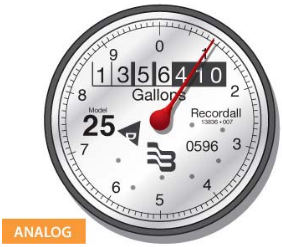The above question is a common call our Operator receives from customers each month. So why do some customers see a sudden spike in their water bills? The reasons will vary. To help determine the reason for an unusually high water bill, look at your water bill and find the amount of water used and then follow the steps below:
Let’s confirm your meter reading – How to read your meter
- Meter styles will vary, but the diagram on the right is typical. The large sweep hand on the dial measures water use in gallons. One gallon of water passes through the water meter as the sweep hand moves from one number to the next (e.g., 0 to 1). A complete rotation equals 10 gallons. Most meters have a low-flow indicator that turns as water moves through the water meter. This typically looks like a small triangle (shown), star or gear.
- Example: The sweep hand is on the “1” so the read is 1,356,411 gallons. The last number on the right is a static zero (does not change). When the sweep hand is on the “3” the read will be 1,356,413 gallons. The meter reads 1,356,410 which is the total number of gallons of water recorded since the meter was installed. Because the billed charge is only in thousand gallons of water, the meter reader discards the last three digits with the black background. The reading shown would be 1356 or 1,356,000 gallons. Look at your most recent water bill. The reading under current reading would now be your previous reading. Subtract the previous reading from the reading on your meter now and you will have the amount of water usage since your last reading.
- If you feel you meter reading was incorrect, call us. Meter reading is done manually and mistakes, while rare, can happen. A service technician will re-read your meter. If an error is discovered, you will receive a billing adjustment.
Do I have a leak?
Most spikes in water use are due to a leak or increased outdoor water use on lawns. Follow these steps
to check for a leak.
- Look at your water meter and locate the low flow indicator, also called a leak detector. Typically this is a small triangle that will slowly turn with low use, and spin rapidly with higher water use.
- Is the triangle turning? If it is, even very slowly, you may have a leak. Check and be sure no water is being used inside or outside the home. If you are not knowingly using water, and the triangle continues to turn, you have a leak.
- If you need help performing this test, call us. We will help you with a no-charge service call to your home. While we cannot enter your home, we can assist you with the test.
Check for toilet leaks
Toilet leaks are one of the most common sources of leaks. Leaky toilets can waste hundreds of gallons a day undetected and should be repaired immediately. Pinpointing a toilet leak is easy and usually inexpensive. Follow these procedures to locate a toilet leak: Wait 5-10 minutes after the last flush.
- Remove tank cover. Is the water level in the tank too high and spilling into the overflow tube? If it is you have a leak.
- While you have the tank cover off, put food coloring, laundry bluing or a leak detector tablet in the toilet tank. Wait at least 30 minutes. If the colored water appears in the bowl, you have a leak.
The meter reading was correct, and I don’t have a leak. Now what?
- Irrigation of lawns is by far the largest use of water during hot, dry months. Check your irrigation controller settings. Water only as needed to keep your lawn healthy. Water in the street after your system runs indicates you are over watering, or that repairs or adjustments may be needed to your irrigation system.
- If you are able, read your meter, run your irrigation system through a complete cycle, and re-read your meter after. The amount of water you use per irrigation cycle can be helpful in determining how much water is used weekly or monthly.
- Other causes of increased water use include:
- Filling of pools
- Guests staying at your home
- Malfunctioning water softeners
Is my water meter accurate?
Water meters lose accuracy as they age. As meters age, the parts wear, causing meters to underregister. This is why we change meters out on a scheduled basis based on water use. Meters will almost never over-register the water used. If you feel your meter isn’t accurate, call us.
Now what?
Some spikes in water use cannot be positively identified. We will assist in investigating high water use complaints, however Cypress Forest cannot control water that passes through the meter. It is the customer’s responsibility to locate and repair leaks and to ensure water is not being wasted.

